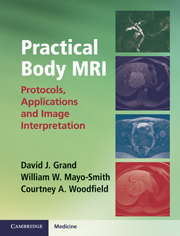Book contents
- Frontmatter
- Contents
- Preface
- To the reader
- Acknowledgments
- Glossary of terms andabbreviations used in Body MRI
- Section 1 Body MRI overview
- Section 2 Abdomen
- Chapter 2 Liver
- Chapter 3 Pancreas and biliary tree
- Chapter 4 Kidneys
- Chapter 5 Adrenal glands
- Chapter 6 MRI enterography
- Section 3 Pelvis
- Section 4 MRI angiography
- Index
- References
Chapter 2 - Liver
from Section 2 - Abdomen
Published online by Cambridge University Press: 05 November 2012
- Frontmatter
- Contents
- Preface
- To the reader
- Acknowledgments
- Glossary of terms andabbreviations used in Body MRI
- Section 1 Body MRI overview
- Section 2 Abdomen
- Chapter 2 Liver
- Chapter 3 Pancreas and biliary tree
- Chapter 4 Kidneys
- Chapter 5 Adrenal glands
- Chapter 6 MRI enterography
- Section 3 Pelvis
- Section 4 MRI angiography
- Index
- References
Summary
Routine liver protocol
Indications
This protocol is used to evaluate the liver parenchyma for suspected mass, including screening for hepatocellular carcinoma, evaluation for metastatic disease, and characterization of lesions detected on other modalities (CT or ultrasound). Other common indications include elevated liver function tests and evaluation of tumor extent (i.e. multifocality).
Preparation
IV contrast agent: 1 mmol/kg gadopentetate dimeglumine at 2 cc/s
Oral contrast agent: none
2 L nasal oxygen
At least 24-gauge IV; connect to power injector
Cover from dome thru entire liver
Exam sequences and what we are looking for
(1) Diffusion-weighted imaging b50, 500/ADC – Very sensitive sequence for lesion detection.
(2) Coronal T2 single-shot fast-spin echo FS BH – Evaluate biliary tree. Detect T2-bright lesions.
(3) Axial T2 SSFSE BH – Identify T2-bright lesions.
(4-5) Axial T1 in- and out-of-phase (IP/OOP) – Identify geographic and microscopic focal fat.
(6) Axial T1-weighted volume-interpolated gradient echo BH pre – Identify anything that is T1-bright before contrast administration, so we don’t mistake it for enhancement.
(7) Axial T1-weighted volume-interpolated gradient echo BH post IV administration of contrast at 20 s – Evaluate for hypervascular lesions.
(8) Axial T1-weighted volume-interpolated gradient echo BH post IV administration of contrast at 1 minute.
(9) Axial T1-weighted volume-interpolated gradient echo BH post IV administration of contrast at 2 minutes.
(10) Axial T1-weighted volume-interpolated gradient echo BH post IV administration of contrast at 3 minutes.
Information
- Type
- Chapter
- Information
- Practical Body MRIProtocols, Applications and Image Interpretation, pp. 13 - 35Publisher: Cambridge University PressPrint publication year: 2012
